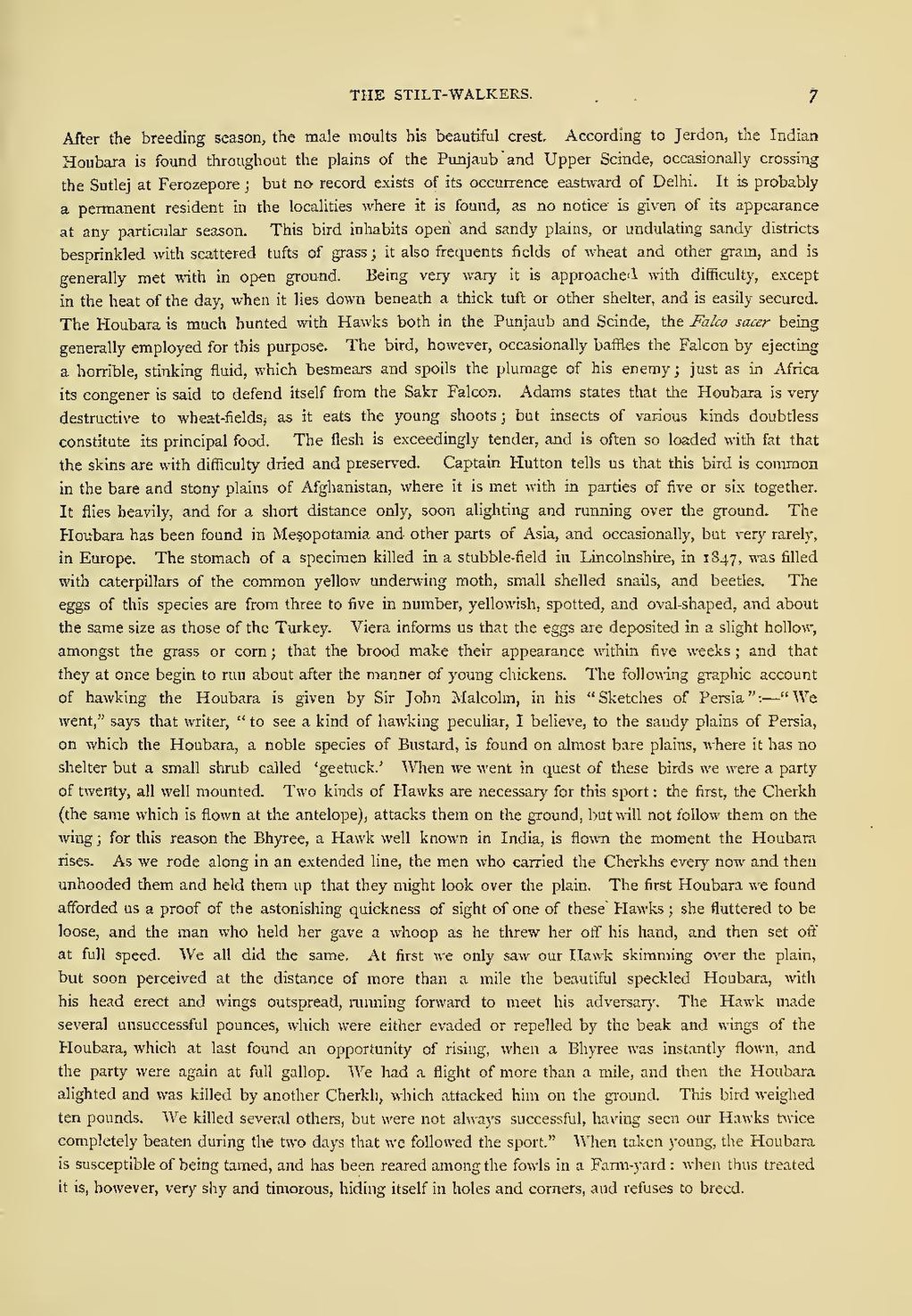After the breeding season, the male moults his beautiful crest. According to Jerdon, the Indian Houbara is found throughout the plains of the Punjaub and Upper Scinde, occasionally crossing the Sutlej at Ferozepore; but no record exists of its occurrence eastward of Delhi. It is probably a permanent resident in the localities where it is found, as no notice is given of its appearance at any particular season. This bird inhabits open and sandy plains, or undulating sandy districts besprinkled with scattered tufts of grass; it also frequents fields of wheat and other grain, and is generally met with in open ground. Being very wary it is approached with difficulty, except in the heat of the day, when it lies down beneath a thick tuft or other shelter, and is easily secured. The Houbara is much hunted with Hawks both in the Punjaub and Scinde, the Falco sacer being generally employed for this purpose. The bird, however, occasionally baffles the Falcon by ejecting a horrible, stinking fluid, which besmears and spoils the plumage of his enemy; just as in Africa its congener is said to defend itself from the Sakr Falcon. Adams states that the Houbara is very destructive to wheat-fields, as it eats the young shoots; but insects of various kinds doubtless constitute its principal food. The flesh is exceedingly tender, and is often so loaded with fat that the skins are with difficulty dried and preserved. Captain Hutton tells us that this bird is common in the bare and stony plains of Afghanistan, where it is met with in parties of five or six together. It flies heavily, and for a short distance only, soon alighting and running over the ground. The Houbara has been found in Mesopotamia and other parts of Asia, and occasionally, but very rarely, in Europe. The stomach of a specimen killed in a stubble-field in Lincolnshire, in 1847, was filled with caterpillars of the common yellow underwing moth, small shelled snails, and beetles. The eggs of this species are from three to five in number, yellowish, spotted, and oval-shaped, and about the same size as those of the Turkey. Viera informs us that the eggs are deposited in a slight hollow, amongst the grass or corn; that the brood make their appearance within five weeks; and that they at once begin to run about after the manner of young chickens. The following graphic account of hawking the Houbara is given by Sir John Malcolm, in his "Sketches of Persia":—"We went," says that writer, "to see a kind of hawking peculiar, I believe, to the sandy plains of Persia, on which the Houbara, a noble species of Bustard, is found on almost bare plains, where it has no shelter but a small shrub called 'geetuck.' When we went in quest of these birds we were a party of twenty, all well mounted. Two kinds of Hawks are necessary for this sport: the first, the Cherkh (the same which is flown at the antelope), attacks them on the ground, but will not follow them on the wing; for this reason the Bhyree, a Hawk well known in India, is flown the moment the Houbara rises. As we rode along in an extended line, the men who carried the Cherkhs every now and then unhooded them and held them up that they might look over the plain. The first Houbara we found afforded us a proof of the astonishing quickness of sight of one of these Hawks; she fluttered to be loose, and the man who held her gave a whoop as he threw her off his hand, and then set off at full speed. We all did the same. At first we only saw our Hawk skimming over the plain, but soon perceived at the distance of more than a mile the beautiful speckled Houbara, with his head erect and wings outspread, running forward to meet his adversary. The Hawk made several unsuccessful pounces, which were either evaded or repelled by the beak and wings of the Houbara, which at last found an opportunity of rising, when a Bhyree was instantly flown, and the party were again at full gallop. We had a flight of more than a mile, and then the Houbara alighted and was killed by another Cherkh, which attacked him on the ground. This bird weighed ten pounds. We killed several others, but were not always successful, having seen our Hawks twice completely beaten during the two days that we followed the sport." When taken young, the Houbara is susceptible of being tamed, and has been reared among the fowls in a Farm-yard: when thus treated it is, however, very shy and timorous, hiding itself in holes and corners, and refuses to breed.
